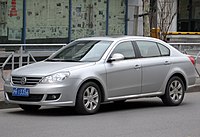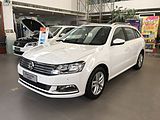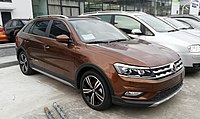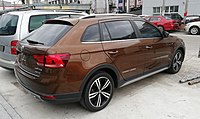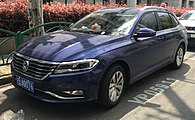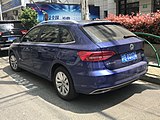| Volkswagen Lavida | |
|---|---|
 | |
| Overview | |
| Manufacturer | Volkswagen |
| Production | 2008–present |
| Body and chassis | |
| Class | Small family car/compact car ( C) |
| Layout | Front-engine, front-wheel-drive |
The Volkswagen Lavida ( Chinese: 大众朗逸; pinyin: Dàzhòng Lǎngyì) is a compact car manufactured by the German automobile manufacturer Volkswagen. Originally launched at Auto China 2008 in Beijing, the Lavida is considered the first mass-produced Volkswagen small family car to be mainly designed by its Chinese partner. In 2010, the car was the number one seller in China, with 251,615 vehicles delivered. [1]
First generation (Typ 18; 2008)
| First generation | |
|---|---|
 | |
| Overview | |
| Also called | Volkswagen Lavida Classic (2012–2018) |
| Production | 2008–2012 |
| Assembly | China: Anting, Shanghai ( SAIC-VW) |
| Body and chassis | |
| Body style | 4-door sedan |
| Platform | Volkswagen Group A4 (PQ34) platform |
| Related |
VW Golf Mk4 VW Jetta/Bora Mk4 VW New Beetle Audi A3 Mk1 Audi TT Mk1 SEAT León Mk1 SEAT Toledo Mk2 Škoda Octavia Mk1 |
| Powertrain | |
| Engine |
Petrol: 1.4 L TSI 131 PS (96 kW; 129 hp) I4 1.6 L EA113,EA111 105 PS (77 kW; 104 hp) I4 2.0 L EA113 120 PS (88 kW; 120 hp) I4 |
| Transmission | 5-speed
manual 6-speed Tiptronic 7-speed DSG |
| Dimensions | |
| Wheelbase | 2,610 mm (102.8 in) |
| Length | 4,605 mm (181.3 in) |
| Width | 1,743 mm (68.6 in) |
| Height | 1,465 mm (57.7 in) |
The first generation Lavida is based on the Volkswagen Group PQ34 platform (PQ34L) and competes with a similar Chinese Volkswagen model produced by FAW-Volkswagen which is the Bora.
At launch, it was equipped with two engine options, which were a 1.6-litre or 2.0-litre. The Lavida 1.4 TSI Sport was added to the range at Auto Shanghai 2009, which uses the same engine as the Sagitar TSI and equipped with either a 5-speed manual transmission or a 7-speed DSG transmission.
Up until the replacement in April 2012, the Lavida sold more than 700,000 units. [2] In July 2015, Volkswagen launched a 'New Lavida' with a redesigned exterior, but resembling a notchback, compared to the first generation Lavida resembling a fastback. [3]
Engines
The Lavida has three engine options: the 1.4-litre turbo, 1.6-litre and 2.0-litre petrol engine. The 1.6-litre engine also powers the Polo Mk4 sedan, while the 2.0-litre engine powers the Volkswagen Passat. The 1.4 TSI engine is shared with the Sagitar, Magotan, Golf Mk6 and Bora. The 2.0-litre engine was dropped in the facelift model of 2012. The 1.4-litre is able to accelerate from zero to 100 km/h (62 mph) in 9.6 seconds, and has a top speed of 190 km/h (118.1 mph). The 1.6L version has a top speed of 180 km/h (111.8 mph). [4]
| name | engine type | displacement | max. power | max. torque | transmission | model years |
|---|---|---|---|---|---|---|
| 1.4TSI | I4 DOHC 16V turbo | 1390 cc | 131 PS (96 kW; 129 hp) | 220 N⋅m (162 lb⋅ft) | 5 speed manual/7 speed DSG | 2010–2012 |
| 1.6 | I4 DOHC 16V | 1598 cc | 105 PS (77 kW; 104 hp) | 155 N⋅m (114 lb⋅ft) | 5 speed manual/6 speed tiptronic | 2008–2012 |
| 2.0 | I4 SOHC 8V | 1984 cc | 120 PS (88 kW; 120 hp) | 172 N⋅m (127 lb⋅ft) | 5 speed manual/6 speed tiptronic | 2008–2012 |
E-Lavida
In 2010, Shanghai Volkswagen unveiled an E-Lavida concept car at Auto China 2010, though no details of production have been forthcoming. [5]
Gallery
Second generation (Typ 18; 2012)
| Second generation | |
|---|---|
 | |
| Overview | |
| Also called | Volkswagen Lavida Qihang (2019–present) |
| Production | 2012–2023 |
| Assembly | China: Anting, Shanghai ( SAIC-VW) |
| Body and chassis | |
| Body style | 4-door
sedan 5-door station wagon |
| Platform | Volkswagen Group A4 (PQ34) platform |
| Related |
VW Golf Mk4 VW Jetta/Bora Mk4 VW New Beetle Audi A3 Mk1 Audi TT Mk1 SEAT León Mk1 SEAT Toledo Mk2 Škoda Octavia Mk1 |
| Powertrain | |
| Engine | |
| Transmission | 5-speed
manual 6-speed Tiptronic 7-speed DSG |
| Dimensions | |
| Wheelbase | 2,610 mm (102.8 in) |
| Length | 4,605 mm (181.3 in) (Lavida) 4,454 mm (175.4 in) (Gran Lavida) 4,467 mm (175.9 in) (Cross Lavida) |
| Width | 1,765 mm (69.5 in) |
| Height | 1,460 mm (57.5 in) 1,490 mm (58.7 in) |
| Curb weight | 1,245–1,325 mm (49.0–52.2 in) |
| Chronology | |
| Predecessor | Volkswagen Jetta Mk6 (Philippines) |
| Successor | Volkswagen Lavida XR |
The range was significantly updated in 2012, with the launch of the New Lavida at the Beijing Auto Show. The 1.4-litre and 1.6-litre engines were carried over, and the 2.0-litre engine option was axed. Power outputs are 96 kW (131 PS) for the 1.4 TSI and 77 kW (105 PS) for the 1.6. The new Lavida is more notchback-looking than the first generation.
The new Lavida retains the 2,610 mm wheelbase, but is slightly lower, shorter and wider. It is built on the platform of the first generation Škoda Octavia and has an extended wheelbase. A new model called the Lavida Lang Xing was introduced as the hatchback variant of the New Lavida. [6]
In May 2018, the Lavida, along with the Tiguan, Santana, and Lamando, was launched in the Philippines as part of the new ASEAN-China Free Trade Agreement (ACFTA).
-
Volkswagen Lavida II sedan (front)
-
Volkswagen Lavida II sedan (rear)
-
interior
-
Volkswagen Lavida II sedan Facelift (front)
-
Volkswagen Lavida II sedan Facelift (rear)
Gran Lavida (2013–2017)
The Volkswagen Gran Lavida is a compact estate produced by Shanghai Volkswagen at its Anting plant. Marketed as a hatchback, it was launched in May 2013, replacing the Lavida Sport saloon.
In mid-2012, the Audi A3 Sportback 8P was used as base for the technical development of a new model. In November, the first test vehicles were seen on Chinese roads. The cars were named Škoda Sportback and had a typical Škoda grille and bumpers, using the typical Audi A3 like headlamps. The taillights resembled the Škoda Octavia II Combi. [7]
The production version of the Gran Lavida was presented in April 2013 at the Shanghai Auto Show. [8] The car adapted the sedan Lavida styling, apart from the B-pillar rearwards. [9] According to initial information, the Gran Lavida was equipped 1.4-litre engine as standard, followed by a 1.8-litre engine and a 2.0-litre as the top engine. A crossover-themed variant of the Gran Lavida called the Cross Lavida commenced production in November 2013.
-
Volkswagen Gran Lavida (front)
-
Volkswagen Gran Lavida (rear)
-
Volkswagen Cross Lavida
-
Volkswagen Cross Lavida (rear)
Third generation (Typ 0C; 2018)
| Third generation | |
|---|---|
 | |
| Overview | |
| Also called | Volkswagen Lavida Plus (2018–2019) |
| Production | 2018–present |
| Assembly | China: Anting, Shanghai; Changsha, Hunan ( SAIC-VW) |
| Body and chassis | |
| Body style | 4-door
sedan 5-door station wagon |
| Platform | Volkswagen Group MQB A1 |
| Related | Volkswagen Bora IV |
| Powertrain | |
| Engine |
Petrol: 1.2 L 116 PS (85 kW; 114 hp) I4 TSI 1.4 L EA211 131 PS (96 kW; 129 hp) I4 TSI 1.5 L EA211 118 PS (87 kW; 116 hp) I4 1.6 L EA211 105 PS (77 kW; 104 hp) I4 |
| Transmission | 5-speed
manual 6-speed automatic |
| Dimensions | |
| Wheelbase | 2,688 mm (105.8 in) |
| Length | 4,670 mm (183.9 in) 4,541 mm (178.8 in) (Gran Lavida) |
| Width | 1,806 mm (71.1 in) |
| Height | 1,474 mm (58.0 in) 1,488 mm (58.6 in) (Gran Lavida) |
The third generation Lavida was launched at Auto China 2018 in Beijing, and is based on the Volkswagen Group MQB platform. At launch, it was equipped with two engine options, including the 1.5-litre petrol engine with 116 hp or the 1.4-litre TSI petrol engine with 150 hp, [10] mated to a five-speed manual gearbox or a six-speed automatic gearbox. [11] It also received an extended 78 mm wheelbase compared to the previous generation. [12]
-
Volkswagen Lavida III (front)
-
Volkswagen Lavida III (rear)
From 2018 to 2019, the Gran Lavida compact estate model was also offered.
-
Volkswagen Gran Lavida 2018 (front)
-
Volkswagen Gran Lavida 2018 (rear)
2022 facelift
The third generation Lavida received a facelift for the 2022 model year. The facelift includes a restyled front end and rear bumper with a slightly revised interior. The 280 TSI models are equipped with a 1.4-litre TSI engine with 150 hp, mated to a DSG gearbox, with a 1.5-litre engine producing 113 hp also available. [13]
-
Volkswagen Lavida 2022 facelift (front)
-
Volkswagen Lavida 2022 facelift (rear)
-
Volkswagen Lavida 2022 Starry Sky Elite Edition (front)
-
Volkswagen Lavida 2022 Starry Sky Elite Edition (rear)
Lavida XR
The Volkswagen Virtus was introduced in June 2023 in China as the Lavida XR, sharing the nameplate with the larger and more advanced third generation Lavida sedan while targeting younger customers. It is mostly identical to the Virtus, with few changes such as a different grille pattern, chrome on the air intake on the front bumpers, and dark-tinted tail lights. It is powered by a 1.5-litre MPI engine producing 108 PS (79 kW; 107 hp) and 141 N⋅m (104 lb⋅ft) with a 6-speed automatic transmission. [14] It replaced the second-generation Lavida and the Santana.[ citation needed]
-
2023 Lavida XR
-
Rear view
Sales
| Year | China [15] |
|---|---|
| 2008 | 44,392 |
| 2009 | 146,455 |
| 2010 | 251,615 |
| 2011 | 247,475 |
| 2012 | 246,687 |
| 2013 | 374,056 |
| 2014 | 371,962 |
| 2015 | 379,069 |
| 2016 | 478,699 |
| 2017 | 461,061 |
| 2018 | 473,564 |
| 2019 | 533,186 |
| 2020 | 419,793 |
| 2021 | 393,496 |
References
- ^ "What Makes Shanghai-VW Lavida the Most Popular Car in China?". China Auto Web. 12 March 2011. Retrieved 22 April 2013.
- ^ "Volkswagen Launches China-Only New Lavida [Beijing Auto Show]". Car and Driver. 25 April 2012. Retrieved 25 February 2013.
- ^ "First Images of the Volkswagen New Lavida for China". Retrieved 22 August 2015.
- ^ "All-new Volkswagen Lavida". China Daily. 27 August 2012. Retrieved 25 February 2013.
- ^ "Volkswagen debuts E-Lavida in China". Autoblog Green. 3 May 2010. Retrieved 25 February 2013.
- ^ "WWW,1343,com-【网址登入】-WWW,95085,com_pj4027,Com". Retrieved 18 November 2022.
- ^ "China Auto Web".
- ^ "Auto Shanghai Live 2013 - VW Gran Lavida steps in". 20 April 2013.
- ^ Surprise at the Shanghai Auto Show April 2013[ dead link]
- ^ "This Is The New Volkswagen Lavida Plus For China". carnewschina.com. 10 April 2018. Retrieved 19 November 2020.
- ^ "Volkswagen Lavida Plus Debuts With Arteon-Inspired Looks And MQB Underpinnings". carscoops.com. 10 April 2018. Retrieved 19 November 2020.
- ^ "【图】采用MQB平台 全新大众朗逸Plus正式亮相_汽车之家". www.autohome.com.cn. Retrieved 25 May 2018.
- ^ "Volkswagen Lavida gets facelift in China". techzle.com. Retrieved 5 March 2023.
- ^ "Volkswagen Virtus launched in China as Lavida XR | Team-BHP". Team-BHP.com. Retrieved 11 June 2023.
- ^ "Volkswagen Lavida China auto sales figures". carsalesbase.com. 22 April 2015. Retrieved 21 September 2020.
